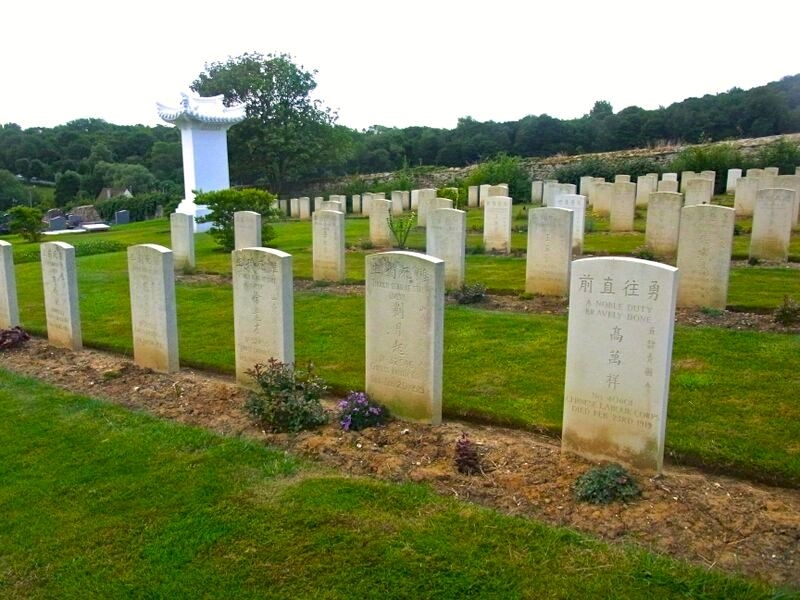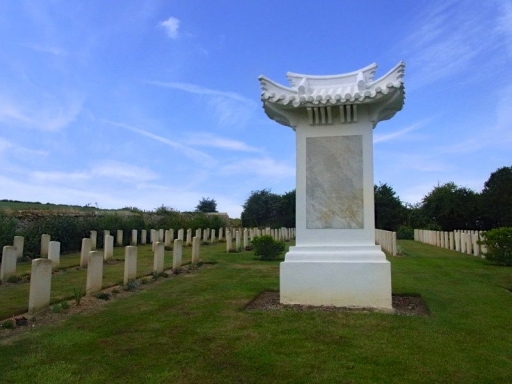Chinese workers recruited to support Britain’s war effort started arriving in France on 19 April 1917, when the first group reached the port of Le Havre.
The Chinese Labour Corps (CLC) was formed to help ease manpower shortages after more than two years of attrition on the Western Front.
100 years on, campaigners say the contribution of these men has been ‘routinely overlooked.’
Carrying out tasks such as digging trenches, building roads and railways, and unloading munitions exposed the labourers to shellfire and other dangers of the front line.
The long voyage to the battlefields of Europe was also hazardous. More than 500 died when the French ship Athos was torpedoed by a German U-boat in the Mediterranean in February 1917.
France was the first Entente power to enlist workers from China, hiring in total some 40,000 men.
The Chinese Labour Corps, recruited by the British, numbered almost 100,000.
Britain also used troops from the South African Native Labour Corps and the British West Indies Regiment for labouring and support duties during the Great War.
With China remaining neutral until August 1917, the Chinese workforce was initially offered in 1916 as non-combatant labour.
Contracted for three years, tens of thousands of workers were retained after the Armistice for the hazardous task of clearing the battlefields.
At least 2,000 members of the CLC died in the First World War, some in the flu pandemic at the end of the conflict.
Centenary Remembrance Projects
 Saint-Étienne-au-Mont Cemetery (Photo: Centenary News)
Saint-Étienne-au-Mont Cemetery (Photo: Centenary News)
The Ensuring We Remember campaign in the UK aims to create a permanent national memorial to the Chinese Labour Corps (CLC) in the UK.
‘The contribution of these men has routinely been overlooked or relegated to a footnote in history,’ it says.
‘These men deserve better, and our nation’s promise never to forget should apply to them as to any other.’
The UK’s first exhibition dedicated to the CLC opened at Durham University’s Oriental Museum on April 7, supported by ‘Ensuring We Remember’.
Drawing on official and private collections, it includes the rediscovered photo archive of WJ Hawkings, a British officer with the CLC.
Exhibition Curator, Dr Craig Barclay, said: “The exhibition’s title – A Good Reputation Endures Forever – recalls one of the inscriptions to be found on the gravestones of the men of the CLC who now rest beneath Flanders Fields.
“Although there has been a considerable rise in interest in the story of the CLC in China, there remains little awareness in the West of the contribution of China during World War I.
“Since 2010, a small number of academic publications have explored the lives of the men of the CLC. No exhibition devoted to the subject has ever been staged in Britain however and the members of the CLC have rightly been described as the ‘forgotten of the forgotten’. “
Steve Lau, Chair of the Ensuring We Remember Campaign, commented: “This is a truly historic exhibition, not only because it is the first such exhibition in the UK, but also because the numerous personal items of British Officers on display, in many ways, challenge the traditional narrative of strained relationships between British Officers and their Chinese charges.”
‘A Good Reputation Endures Forever: The Chinese Labour Corps on the Western Front’ runs until 24 September 2017 at the Oriental Museum, Durham University.
The Meridian Society in London has also launched an 18-month programme of events commemorating the Chinese Labour Corps – we have a report in Centenary News.
Sources: Ensuring We Remember/CWGC/ Wikipedia/various
Images: Centenary News
Posted by: CN Editorial Team
